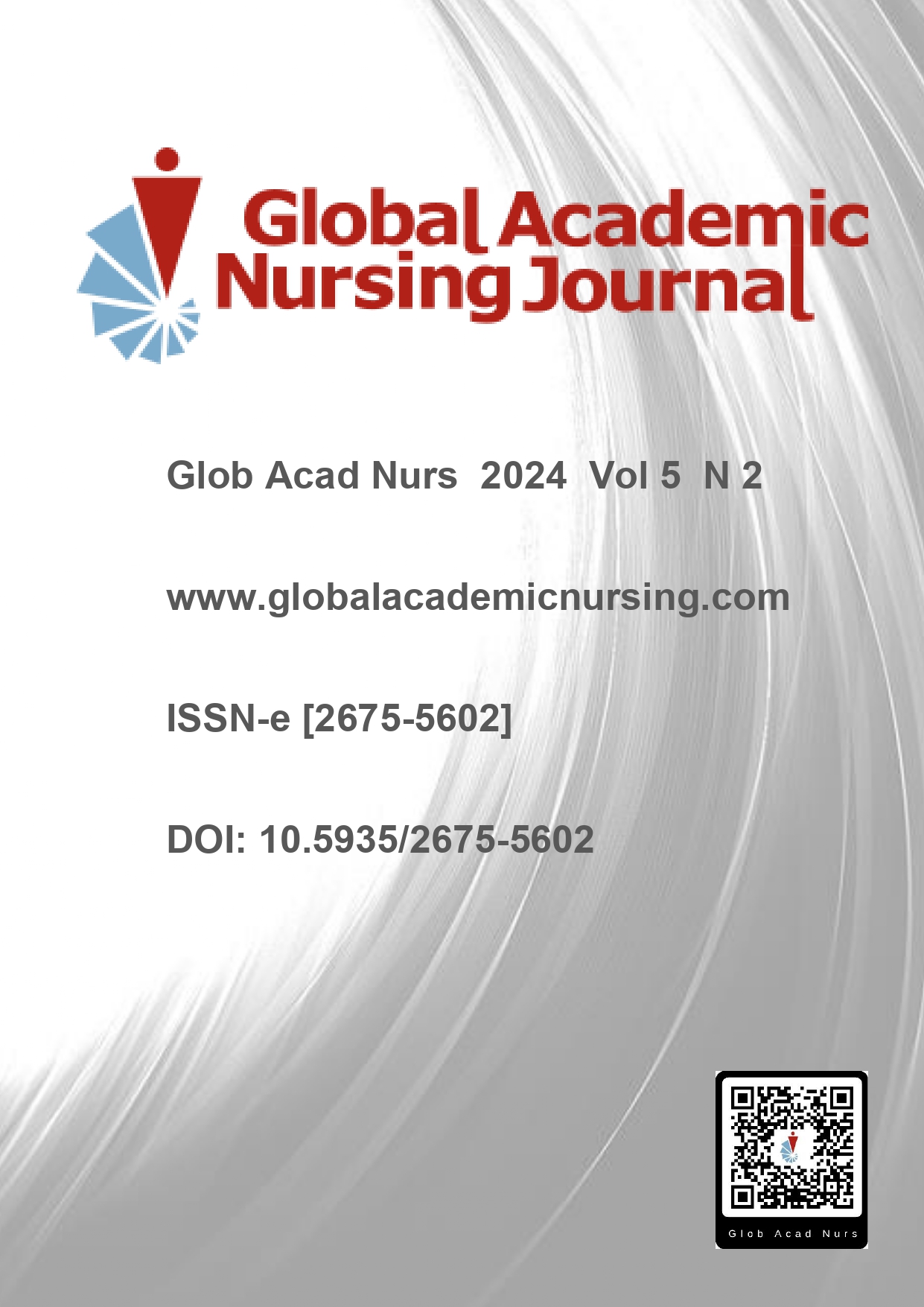Abstract
This study aimed to analyze and discuss how circadian changes interfere with night-shift health workers' lives. This is a descriptive literature review with bibliometric analysis that aims to describe and analyze the profile of publications worldwide on circadian changes related to night shift work and their correlation with cardiovascular comorbidities. Analyses were made of publications that correlated night work with cardiovascular risk from 2000 to 2023 and published in the LILACS, MEDLINE via PubMed and BVS databases. Using the JoinPoint program, a segmented regression analysis was performed, which did not show any inflection points, explaining the increasing constancy in the publications. The annual percentage variation was estimated at 13.9%, with 95% confidence intervals. It was found that the United States of America has the highest percentage of studies on the subject, approximately 27.5% more than Brazil. At the same time, there is a demonstrated lack of studies in the continents of Oceania, Africa, and Central America. It was concluded that to reduce the prevalence of cardiovascular diseases and better understand the underlying biological mechanisms of work activities, it was important to understand the working conditions and the correlation with the occupational health disease process.
References
Organização Pan-Americana da Saúde (OPAS). OMS revela principais causas de morte e incapacidade em todo o mundo entre 2000 e 2019 [Internet]. OPAS/OMS; 2020 [acesso em 24 jan 2024]. Disponível em: https://www.paho.org/pt/noticias/9-12-2020-oms-revela-principais-causas-morte-e-incapacidade-em-todo-mundo-entre-2000-e#:~:text=A%20doen%C3%A7a%20card%C3%ADaca%20permanece%20a
Sociedade de Cardiologia do Estado de São Paulo (SOCESP). Hipertensão atinge mais de 30 milhões de pessoas no Brasil. SOCESP; 2018 [acesso em 24 jan 2024]. Disponível em: https://socesp.org.br/noticias/area-medica/hipertensao-atinge-mais-de-30-milhoes-de-pessoas-no-brasil/
Pan American Health Organization (PAHO). Doenças cardiovasculares [Internet]. 2020 [acesso em 24 jul 2024]. Disponível em: https://www.paho.org/pt/topicos/doencas-cardiovasculares
Wang N, Sun Y, Zhang H, et al. Long-term night shift work is associated with the risk of atrial fibrillation and coronary heart disease. European Heart Journal. 2021;42(40):4180–8. https://doi.org/10.1093/eurheartj/ehab505
Gomes CS, Gonçalves RPF, Silva AGD, Sá ACMGND, Alves FTA, Ribeiro ALP, Malta DC. Fatores associados às doenças cardiovasculares na população adulta brasileira: Pesquisa Nacional de Saúde. Rev Bras Epidemiol. 2021;24:e210013. https://doi.org/10.1590/1980-549720210013.supl.2
Sociedade Brasileira de Cardiologia (SBC). Diretriz de Hipertensão Associados [Internet]. SBC: 2010 [acesso em 24 jul 2024]. Disponível em: http://publicacoes.cardiol.br/consenso/2010/Diretriz_hipertensao_associados.pdf
Ministério da Saúde (BR). Hipertensão Arterial Sistêmica: o que é, quais os riscos e como prevenir a doença e os agravos. Secretaria de Atenção Primária à Saúde; 2020.
Jornal Brasileiro de Economia em Saúde (JBES) [Internet]. 2022 [acesso em 24 jul 2024]. Disponível em: https://jbes.com.br/wp-content/uploads/2022/12/JBES_142-p149-161.pdf
Fundação Jorge Duprat Figueiredo, de Segurança e Medicina do Trabalho (Fundacentro). Trabalhadores noturnos relatam mais sonolência e fadiga [Internet]. Fundacentro; 2022 [acesso em 26 mai 2023]. Disponível em: https://www.gov.br/fundacentro/pt-br/comunicacao/noticias/noticias/2022/janeiro/trabalhadores-noturnos-relatam-mais-sonolencia-e-fadiga
Costa AS, Griep RH, Rotenberg L. Disentangling the effects of insomnia and night work on cardiovascular diseases: a study in nursing professionals. Braz J Med Biol Research. 2015;48(2):120–7. https://doi.org/10.1590/1414-431X20143965
Azambuja AAA, Dias FM, Bottcher LB. Os efeitos do trabalho noturno na saúde dos profissionais. RIEC. 2019; 6;2(1):582–92. https://doi.org/10.1000/riec.v2i1.25
Chellappa SL, Vujovic N, Williams JS, Scheer FAJL. Impact of Circadian Disruption on Cardiovascular Function and Disease. Trends in Endocrinology & Metabolism. 2019;30(10):767–79. https://doi.org/10.1016/j.tem.2019.07.008
Santos CMC, Pimenta CAM, Nobre MRC. The PICO strategy for the research question construction and evidence search. Rev Latino-Am Enferm [Internet]. 2007 [acesso em 24 mai 2024];15(3):508–11. Disponível em: https://www.scielo.br/j/rlae/a/CfKNnz8mvSqVjZ37Z77pFsy/?lang=en
Wong R, Crane A, Sheth J, Mayrovitz HN. Shift Work as a Cardiovascular Disease Risk Factor: A Narrative Review. Cureus. 2023 Jun 30;15(6):e41186. doi: 10.7759/cureus.41186
Chau NP, Mallion JM, de Gaudemaris R, Ruche E, Siche JP, Pelen O, Mathern G. Twenty-four-hour ambulatory blood pressure in shift workers. Circulation. 1989 Aug;80(2):341-7. doi: 10.1161/01.cir.80.2.341
Su TC, Lin LY, Baker D, Schnall PL, Chen MF, Hwang WC, Chen CF, Wang JD. Elevated blood pressure, decreased heart rate variability and incomplete blood pressure recovery after a 12-hour night shift work. J Occup Health. 2008;50(5):380-6. doi: 10.1539/joh.l7056
Moses H, Matheson DHM, Cairns-Smith S, George BP, Palisch C, Dorsey ER. The Anatomy of Medical Research. JAMA. 2015; 13;313(2):174. doi:10.1001/jama.2014.15939
Chellappa SL, Vujovic N, Williams JS, Scheer FAJL. Impact of Circadian Disruption on Cardiovascular Function and Disease. Trends Endocrinol Metab. 2019;30(10):767-779. doi: 10.1016/j.tem.2019.07.008
Bøggild H, Knutsson A. Shift work, risk factors and cardiovascular disease. Scand J Work Environ Health. 1999 Apr;25(2):85-99. doi: 10.5271/sjweh.410
Vetter C, Fischer D, Matera Joana L, Roenneberg T. Aligning Work and Circadian Time in Shift Workers Improves Sleep and Reduces Circadian Disruption. Current Biology. 2015;25(7):907–11. http://dx.doi.org/10.1016/j.cub.2015.01.064
Morris CJ, Purvis TE, Mistretta J, Hu K, Scheer FAJL. Circadian Misalignment Increases C-Reactive Protein and Blood Pressure in Chronic Shift Workers. J Biol Rhythms. 2017 Apr;32(2):154-164. doi: 10.1177/0748730417697537
Oliveira NA, Fernandes FSL, Siqueira LD, Okuno MFP, Miura CRM. O uso do cenário clínico realístico do ensino da enfermagem emergência e emergência. Glob Acad Nurs. 2022;3(5):e335. https://doi.org/10.5935/2675-5602.20200335

This work is licensed under a Creative Commons Attribution-NonCommercial-NoDerivatives 4.0 International License.
Copyright (c) 2024 Global Academic Nursing Journal

